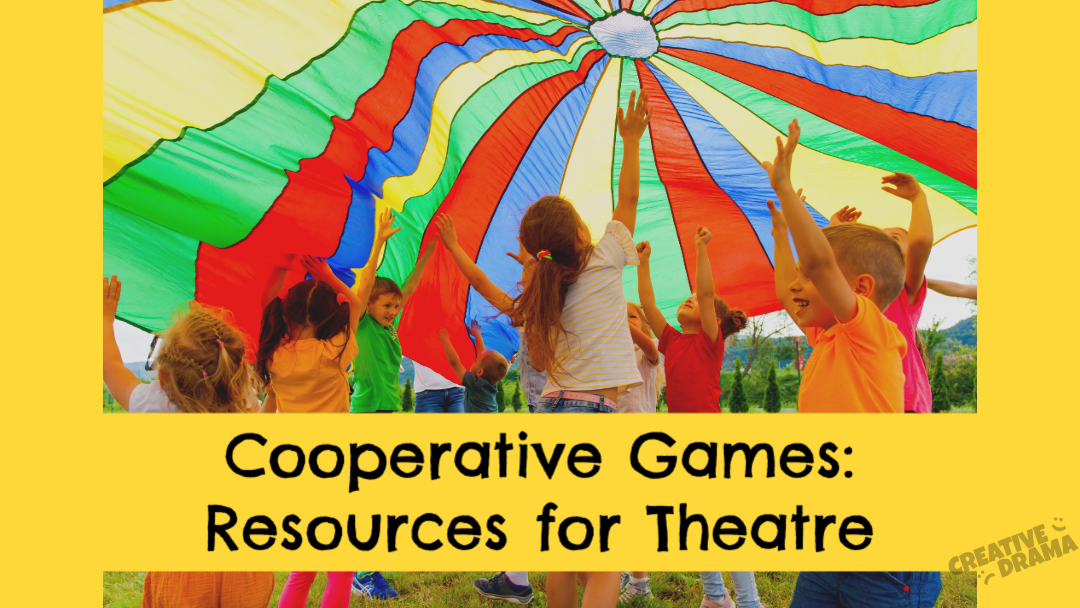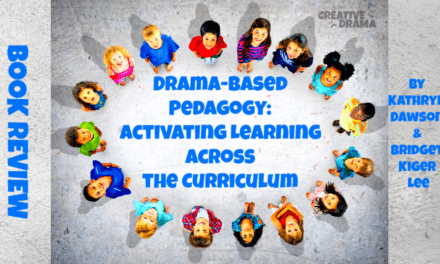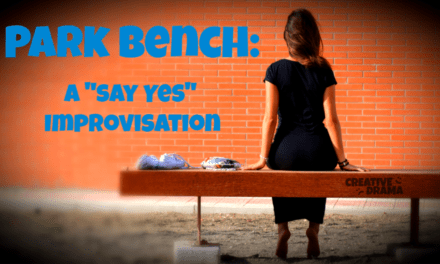Cooperative games in which “everybody wins” are a great resource for use in theatre. Working together to meet a goal is a foundation in the art of theatre. A cooperative game by its very nature creates group cohesiveness, which helps your class or cast become united. Many cooperative games are physically active – a common theme is adapting a typical “competitive” sport into a “cooperative” one. They’re great for burning off excess energy or charging up participants. You can easily adapt many cooperative games to fit the theme of your class, workshop, or rehearsal. If you’re in a situation with outdoor spaces like a camp, you don’t have to worry about the limitations of walls.
For a game to be truly cooperative:
- Participants have to WORK TOGETHER towards a goal
- NO ONE IS ELIMINATED from play due to a lack of skill – although they may change roles depending on the play of the game.
- EVERYBODY WINS, or at least no one “loses.”
There are games that include some of these guidelines, but not others; often people call those “cooperative” games as well.
Contents
The New Games Movement
In the late 1960s, a movement started in San Francisco that challenged some of the underlying philosophies of playground and gym class games. The originators of the “New Games” movement wanted to emphasize cooperation and fun over competition and winning. If you’re thinking that it sounds like a “hippie” idea, you would be right; many of the practitioners were members of the counterculture. The New Games movement eventually hosted tournaments of their cooperative games, many of which featured players switching from one team to another. Practitioners founded the New Games Foundation, which lasted until the mid-1980s.
You can read more about the New Games Foundation here. There’s also a more cynical look at the movement here. )
Many of the titles I’ve listed below are by authors who worked with the New Games Foundation. Dale LeFevre, who was an Associate Director there, has a website and offers workshops for a wide variety of groups.
Orlick, Terry. The Cooperative Sports and Games Book.
Pantheon Books, New York, 1978.
The absolutely delightful Dedication for The Cooperative Sports and Games Book reads, “TO THE WOMEN OF THE WORLD: for maintaining some sanity and tenderness in our children, our games, our existence, and for giving me some legitimate hope for the future.” That might give you an idea of the cultural milieu of Terry Orlick.
Orlick was a professor in Psychology of Sport at the University of Ottowa when he wrote his Cooperative Sports and Games books. In the Introduction, Orlick explains in depth the underlying philosophy and benefits of Cooperative Sports. He expresses dismay at the “industrialization” of children’s sports, with its comorbid rigidity, judgement, and rejection. Orlick thinks games should have four essential components: COOPERATION, ACCEPTANCE, INVOLVEMENT, and (of course!) FUN.
Through his academic research, Orlick learned about the cooperative games of the Inuit in the Canadian Arctic; he includes a chapter of cooperative games from around the world. The book also has games for 3-to-7-year-olds, 8-to-12-year-olds, and adults in addition to chapters on working with preschoolers and creating and evaluating your success.
Orlick developed many of these games through trial-and-error work with students. There are a lot of “collective score” games in which the entire group has a goal to score points.
Some of my favorites include: Tug of Peace (15), Beach Ball Balance (17), and Frozen Bean Bag (20). I know “Tweetie” (48) as “Prui” (see Everybody Wins later in this post). “Nonverbal Birthday Lineup” ( ) is a great icebreaker for a new class/workshop/camp, especially when the students can share something about their birthday while they’re checking to see if they’re lined up correctly.
“Muk,” from the chapter “Cooperative Games from Other Cultures,” (Orlick’s title, he means “non-Western”) is similar to the game “Honey, I Love You” that theatre kids play to make each other “break character.”
The final chapter on “Creating Your Own Games; Evaluating Your Success” suggests that participants themselves (even preschool-aged ones) are a great resource for game creation. Orlick includes 14 games created by elementary and high school students as examples; one of them, “Find Your Prey” (91) has applications in a science class studying the food chain. There’s also an Appendix of evaluation questions that leaders can ask themselves and participants.
Appendix B in The Cooperative Sports and Games Book has games designed for special populations. There are “Integrated Development Games” – what educators today often term “cross-curricular” – to help physically active students work on academic and social skills. The sections on “Cooperative Perceptual Motor Development Games” and “Cooperative Dynamic Balance Activities” focus on proprioceptive and hand-eye coordination skills.
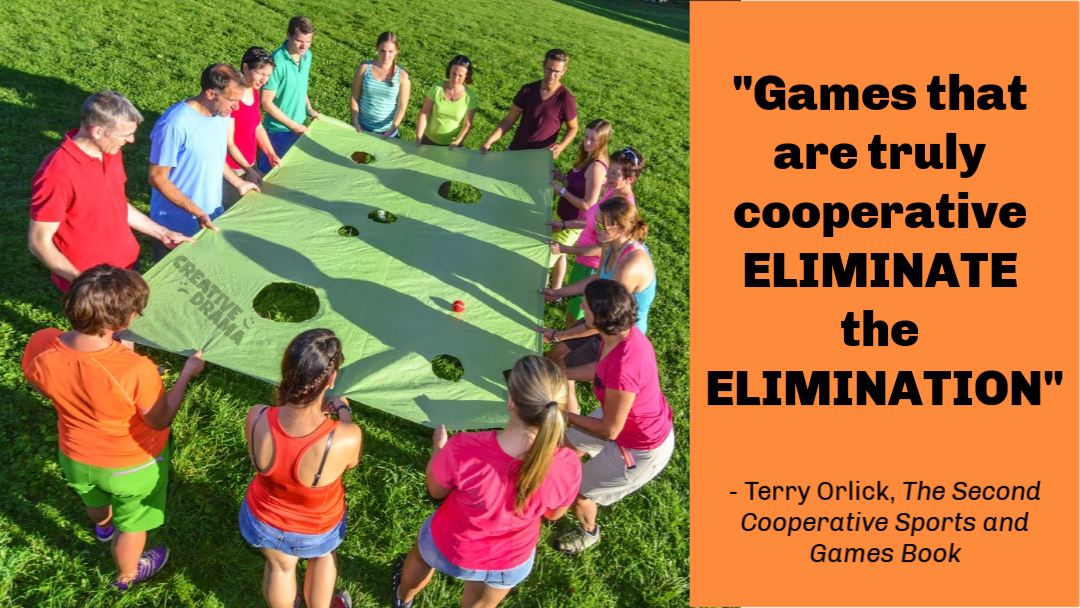
Orlick, Terry. The Second Cooperative Sports and Games Book. Pantheon Books, New York, 1982.
The cover of The Second Cooperative Sports and Games Book pictures the only time I recall actually having fun in gym class: PARACHUTE PLAY. The fact that Orlick follows it with an epigraph of Shel Silverstein’s “Hug of War” is the cherry on top of his book sundae for me. In the four years between the publication of The Cooperative Sports and Games book and this one, Orlick did more field research on traditional cooperative games in many cultures, and more work with kids in Ottowa, Canada.
Orlick’s introductory chapter, “The Magic Realm of Play,” is an excellent essay outlining the philosophy behind cooperative games and their benefits for participants.
In “Finding and Creating Your Own Play Equipment,” Orlick points out that children used to make their own sports equipment and toys, and in many places they still do. He has lots of ideas for nature-based play equipment, provides several examples of children making their own flutes, and makes suggestions for adapting sports equipment for use by children.
The section on “Cooperative Games for the Tiniest Tots” has Orlick detailing what may seem to be painfully obvious baby games like “Pat-a-Cake” and “Block Building.” I needed to remind myself that not everyone knows how to play simple, no-equipment games with kids, or even that they should; if they did, there wouldn’t be such a large market for electronic baby toys.
Orlick also includes chapters with games from Inuit, Papua New Guinean, Malay, Maori, and Chinese cultures. There’s also a section on games from the German Democratic Republic (East Germany was at the time part of the Soviet Union); these are very acrobatic – I’d want to enlist the support of a gymnastics or cheerleading coach before trying them.
There are also sections on cooperative games for all abilities – Orlick titled these “Cooperative Games for Handicapped Children” and “Mainstreaming with Cooperative Games” – that were workshopped with students and teachers in North America. Orlick has fully embraced the change in educational philosophy regarding populations with physical and intellectual disabilities that happened in the 1960s, but some of the some of the ideas and terminology are very much of the 1970s/early 1980s. Teachers can adjust the games to reflect contemporary practices in special education.
There is ALSO an entire chapter on “Cooperative Parachute and Earth Ball Games” (207); if you have access to a parachute and enough space, try some of them!
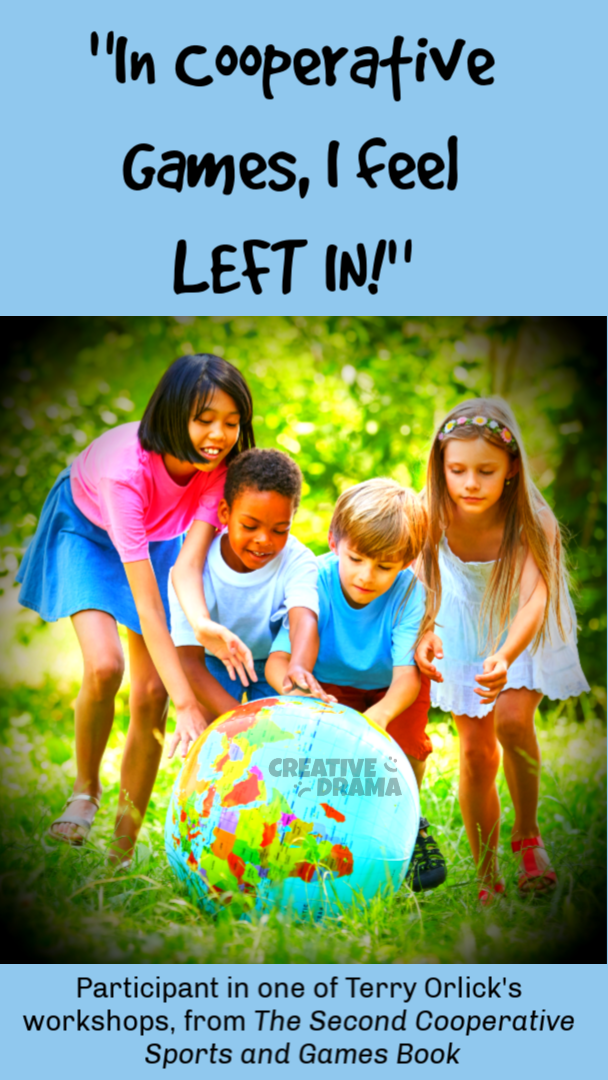
Aycox, Frank. Games We Should Play in School: A Revealing Analysis of the Social Forces in the Classroom and a Practical Approach to Understanding and Shaping Them, Including over 55 Dynamic and Fun Social Games. Byron, CA, Front Row, 1985
Games We Should Play in School is out-of-print, but it’s worth hunting down a copy if you can. Google Books has a preview of the second edition with portions from the first three chapters. Aycox specialized in therapeutic recreation in educational and institutional settings in the Philadelphia area. His notes in the “teacher’s guide” section for each game evidence his attentiveness to potential challenges and benefits for the activities.
Aycox includes two introductory essays as well as chapters on “Why Social Play Works,” “Making the System Work,” and “Behavior Problems in the Schools.”
Each of the 60 activities in Games We Should Play in School includes sections for:
- Objective – Aycox describes the social/emotional/physical benefit of the game
- Number of Players
- Place – location(s) where the game could be played
- Equipment
- Formation – How participants arrange themselves
- Description
- Action – How to play the game
- Teacher’s Guide – Aycox explains what participants enjoy about the game, warns about possible stumbling blocks, and makes suggestions for starting points.
Many of the games also have a “Variation” section, and each explanation is clear and easy-to-understand.
Not all the games in the book fit the classification of a cooperative game, but Aycox is very clear in the “Objective” section if the activity has a competitive component. Even in competitive team games, the emphasis is on the team members cooperating.
Some games Aycox says provide constructive outlets for aggression, anger, or hostility may have been acceptable in 1985, but they WILL require adjustments before playing in the 21st Century. In particular, “Swat,” which involves a rolled-up newspaper, and “Bull in the Ring,” which is a circle-based variant on “Red Rover,” are potential generators of interpersonal conflict or injury.
However, most of the games can easily fit into a classroom or workshop setting. “In the Manner of the Adverb” (44) would be a great game to play with kids just learning to identify and use adverbs. “Predicament” (51), which Aycox describes as a deductive reasoning game, has the person who’s “it” guessing what situation the other players have chosen based on their answers to the question, “What would you do?” It’s purely verbal game in the book, but a theatre teacher could easily adapt it so that participants are pantomiming their answers instead of/in addition to saying them aloud.
Sobel, Jeffrey. Everybody Wins: 393 Non-competitive Games for Young Children. Walker Publishing Company, New York, 1983.
Jeffrey Sobel developed the games in Everybody Wins for 3-10-year-olds. He learned some of them while participating in New Games Foundation work – one of more “hippie” games is called “No Nukes” – and adapted others from typical playground games. He is hopeful that “If our children play cooperatively from an early age, by the time they are adults they will have learned the value of cooperation, and society as a whole might well be in better shape.” (3)
There aren’t a lot of directions for most of the games in the book, but many don’t need a lot of explanation. If you’re new to theatre games or cooperative games, you might want to imagine “What sorts of challenges is this going to create for participants?” and front-load some extra ground rules into your session.
If there’s a competitive game you’re interested in playing, it’s likely that Sobel presents a cooperative version in his “Old Favorites in a New Way” chapter. There are cooperative versions of jacks, “Pin the Tail on the Donkey,” “Duck, Duck, Goose,” and even a “Nonelimination Simon Says.” “Cooperative Musical Chairs” (55), in which the same number of people try to make contact with a diminishing number of chairs, is a lot of fun. You probably know the game Sobel calls “Indian Chief” (53) as “Who’s the Leader?”.
I’d want to run through some of the games ahead of time with experienced theatre students before introducing them to the Kindergarten-age suggestions. For example, “Rubber Band,” which asks students in a circle to stretch out as far as they can without snapping, seems like a good group cohesiveness exercise. But I’d try it with older elementary and up rather than the “all ages” Sobel suggests; I think younger students might have difficulty judging how hard they’re pulling on each other’s hands/arms. “Leaps into Small Spaces” (13) has the objective of having two people “land very close together but not touch” after running and jumping towards one another. This sounds to me like a sure way for someone to get hurt, especially if you have participants with proprioceptive issues.
There are, however, plenty of games that emphasize proprioception with little likelihood of injury. “Aura,” (15-16) is a gentle exercise for working on proprioception, with the partners trying to touch their outstretched hands together after turning around with their eyes closed. “Spokes” (78) has the participants moving slowly as a “wheel” with their hands touching. “Fox and Squirrel” (89) is a great game for hand-eye-peripheral vision coordination; I’ve played a variant of this involving two balls and a “groan stick.”
Sobel states that “Octopus” is a favorite of preschoolers and kindergarteners: as the player who’s the Octopus tags others (the Fish), they become Tentacles and can also tag the Fish. Its constant participation and team-switching would make a good introduction to a cooperative “tag” game. Some are cooperative classics that kids have played for generations; “Lemonade” (41) is a game I’ve played with introductory theatre classes; it gets the students pantomiming in a group and moves fast enough that self-consciousness is at a minimum.
I know one of Sobel’s games, “Elephant/Palm Tree,” as “Elephant/Palm Tree/Monkey,” and have played it successfully with high school students. “Prui” (98) is also a favorite of mine, if your participants can manage blindfolds or darkness (“Blob” is a variant of this game).
Sobel has an interesting Mirror Exercise variant called “Shadows” (12) that would be effective for participants who can’t control their giggles when standing face-to-face with a partner. The follower stands behind the leader and “shadows” their movements.
I want to share one of Sobel’s best pieces of advice, so that you have it even if you’re unable to find a copy of the book: “At the beginning of the play period there may be a few children who are hesitant about playing, for one reason or another. Treat such children carefully, or you may lose them. Have some of the others try to coax a hesitant child to play, or do it yourself, but don’t push. Let him or her sit and watch the others. Usually, after a short time the reluctant child will join in – possibly with little more coaxing and assuredly with a lot more enthusiasm than initially.” (4)
Internet Resources for Cooperative Games:
Cooperative games make effective team-building exercises in the work world in addition to being fun for kids in school and out of school. There are many resources available online; here are a few especially useful ones.
Benefits of cooperative games from CooperativeGames.com – The website sells cooperative board games in addition to an anti-bullying program based on cooperative play.
CooperativeGames.com also has some game explanations with curricular connections.
Mr. Gym has a list of cooperative games; although some of them have an elimination component, “Crossing the Great Divide” and “Prouty’s Landing” are truly cooperative.
The Drama-Based Instruction website from the University of Texas – Austin has A TON of cooperative games.
Becky’s Guiding Resource Centre – a website for Girl Guides leaders – has a lot of cooperative games (look on the left-hand sidebar for the list).
Other Books Featuring Cooperative Games:
If you’re familiar with any of these titles, I’d love to hear about them in the comments!
Boyd, Neva L. Handbook of Recreational Games: How to Play More Than 300 Children’s Games. New York, Dover Publications, 1975.
Brandes, Donna, and Howard Phillips. Gamester’s Handbook. Hutchinson, London.
Deacove, Jim. Games Manual of Non-Competitive Games. Perth, Ontario, Canada: Jim Deacove, 1974.
Deacove, Jim. Cooperative Games Manual Supplement. Perth, Ontario, Canada: Jim Deacove, 1978.
Deacove, Jim. Sports Manual of Non-Competitive Games. Perth, Ontario, Canada: Jim Deacove, 1978.
DeKoven, Bernard. The Well-Played Game: A Player’s Philosophy. Garden City, New York; Anchor Books/Doubleday, 1976.
Fluegelman, Andrew, ed. New Games Book. Doubleday, New York, 1976.
Fluegelman, Andrew, ed.More New Games. Garden City, New York: Dolphin Books/Doubleday, 1981.
Harris, Frank. Games. Phildelphia: Frank Harris, 1976.
Harrison, Marta and The Nonviolence for Children Program. For the Fun of It: Selected Cooperative Games for Children and Adults.
Philadelphia; NonViolence and Children, Friends Peace Committee, 1975.
Le Fevre, Dale N. Best New Games. Champaign, Illinois: Human Kinetics, 2012.
Le Fevre, Dale N. The Spirit of Play: Cooperative Games for All Ages, Sizes, and Abilities. Findhorn, Forres, Scotland: Findhorn Press,
2007.
Lentz, Theo, and Ruth Cornelius. All Together: A Manual of Cooperative Games. St. Louis: Peace Research Laboratory, 1950.
Luvmour, Josette and Ba. Everyone Wins! Cooperative Games and Activities for All Ages. Gabriola Island, British Columbia, Canada: New
Society Publishers, 2019.
Masheder, Mildred. Let’s Play Together: Over 300 Co-operative Games for Children and Adults. London: Merlin Press, 1989.
Michaelis, Bill and Dolores. Learning Through Non-Competitive Play Activities. Palo Alto, CA: Education Today Co., 1977.
Orlick, Terry. Cooperative Games and Sports: Joyful Activities for Everyone. Champaign, Illinois: Human Kinetics, 2006.
Orlick, Terry. Winning Through Cooperation. Washington, D.C. Acropolis Books, 1978.
Orlick, Terry and Cal Botterill Every Kid Can Win. Chicago: Nelson Hall, 1975.
Schnieder, Tom. Everybody’s a Winner. Boston: Little, Brown, & Co. 1976.
Weinstein, M. and Goodman, J. Play Fair: Everybody’s Guide to Noncompetitive Play. San Luis Obispo, CA: Impact Publishers, 1980.
CreativeDrama.com also has cooperative games; here are some of my favorites:

